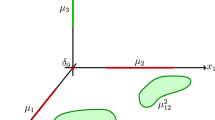Abstract
We focus on the long-term dynamics of “killing the winner” Lotka–Volterra models of marine communities consisting of bacteria, virus, and zooplankton. Under suitable conditions, it is shown that there is a unique equilibrium with all populations present which is stable, the system is permanent, and the limiting behavior of its solutions is strongly constrained.

Similar content being viewed by others
References
Butler GJ, Wolkowicz GSK (1986) Predator-mediated coexistence in the chemostat. J Math Biol 24:167–191
Butler GJ, Wolkowicz GSK (1987) Predator-mediated coexistence in a chemostat: coexistence and competition reversal. Math Model 8:781–785
Caswell H (1978) Predator-mediated coexistence: a nonequilibrium model. Am Nat 983:127–154
Flores CO, Valverde S, Weitz JS (2013) Multi-scale structure and geographic drivers of cross-infection within marine bacteria and phages. ISME J 7:520–532
Haerter JO, Mitarai N, Sneppen K (2014) Phage and bacteria support mutual diversity in a narrowing staircase of coexistence. ISME J 8:2317–2326
Hale JK (1980) Ordinary differential equations. Robert E. Krieger Publishing Co, Malabar
Hofbauer J, Sigmund K (1998) Evolutionary games. Cambridge University Press, Cambridge
Hsu SB (1981) Predator-mediated coexistence and extinction. Math Biosci 54:231–248
Jover LF, Cortez MH, Weitz JS (2013) Mechanisms of multi-strain coexistence in host-phage systems with nested infection networks. J Theor Biol 332:127–154
Korytowski D, Smith HL (2015a) How nested and monogamous infection networks in host-phage communities come to be. Theor Ecol 8:111–120
Korytowski D, Smith HL (2015b) Persistence in phage–bacteria communities with nested and one-to-one infection networks. arXiv:1505.03827 [q-bio.PE]
Korytowski D, Smith HL (2017) Persistence in phage–bacteria communities with nested and one-to-one infection networks. Discrete Contin Dyn Syst B 22(3):859–875
Korytowski DA, Smith HL (2016) A special class of Lotka–Volterra models of bacteria–virus infection networks. In: Cushing J, Saleem M, Srivastava H, Khan M, Merajuddin M (eds) Applied analysis in biological and physical sciences. Springer proceedings in mathematics & statistics, vol 186. Springer, New Delhi
Law R, Morton RD (1996) Permanence and the assembly of ecological communities. Ecology 77:762–775
Smith H, Thieme HR (2011) Dynamical systems and population persistence. GSM 118, American Mathematical Society, Providence
Smith HL, Zhao X-Q (2001) Robust persistence for semidynamical systems. Nonlinear Anal 47:6169–6179
Suttle C (2007) Marine viruses-major players in the global ecosystem. Nat Rev Microbiol 5:801–812
Thieme HR (1993) Persistence under relaxed point-dissipativity (with application to an endemic model). SIAM J Math Anal 24:407–435
Thingstad TF (1997) Theoretical models for the control of bacterial growth rate, abundance, diversity and carbon demand. Aquat Microb Ecol 8:19–27
Thingstad TF (2000) Elements of a theory for the mechanisms controlling abundance, diversity, and biogeochemical role of lytic bacterial viruses in aquatic systems. Limnol Oceanogr 45:1320–1328
Thingstad TF (2001) Trade-offs between competition and defense specialists among unicellular planktonic organisms: the killing the winner hypothesis revisited. Microbiol Mol Biol Rev 8:42–57
Thingstad TF (2014) A theoretical analysis of how strain-specific viruses can control microbial species diversity. Proc Nat Acad Sci USA 8:7813–7818
Weitz JS (2016) Quantitative viral ecology: dynamics of viruses and their microbial hosts. Princeton University Press, Princeton
Wolkowicz GSK (1989) Successful invasion of a food web in a chemostat*. Math Biosci 93:249–268
Acknowledgements
The authors would like to thank the anonymous reviewer for their valuable comments and suggestions to improve the quality of the paper. This work was supported by a Grant from the Simons Foundation (355819, H.L.S.).
Author information
Authors and Affiliations
Corresponding author
Rights and permissions
About this article
Cite this article
Korytowski, D.A., Smith, H. Permanence and Stability of a Kill the Winner Model in Marine Ecology. Bull Math Biol 79, 995–1004 (2017). https://doi.org/10.1007/s11538-017-0265-6
Received:
Accepted:
Published:
Issue Date:
DOI: https://doi.org/10.1007/s11538-017-0265-6




